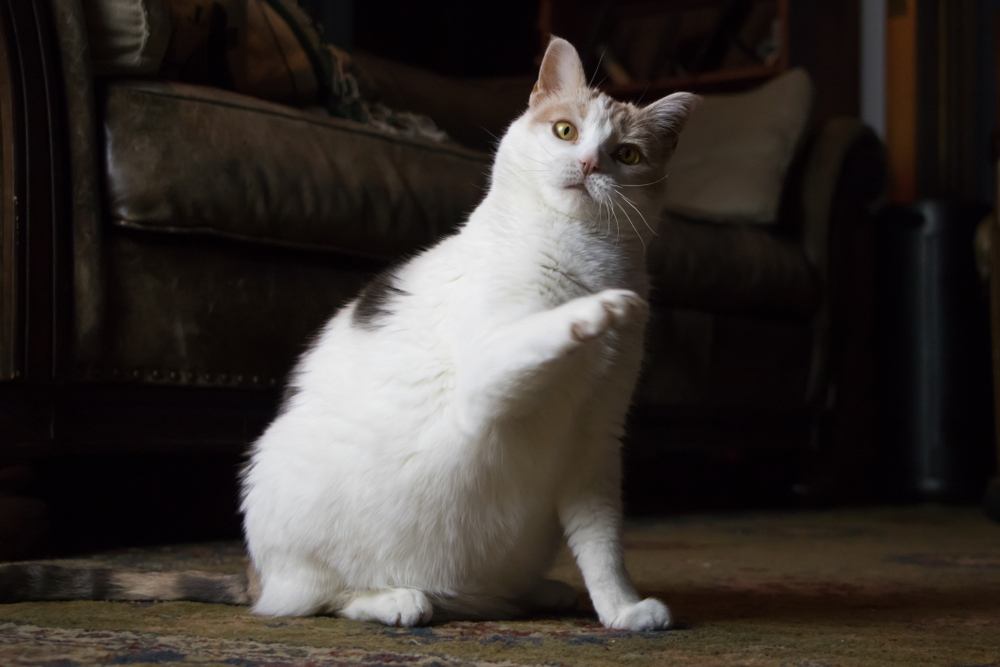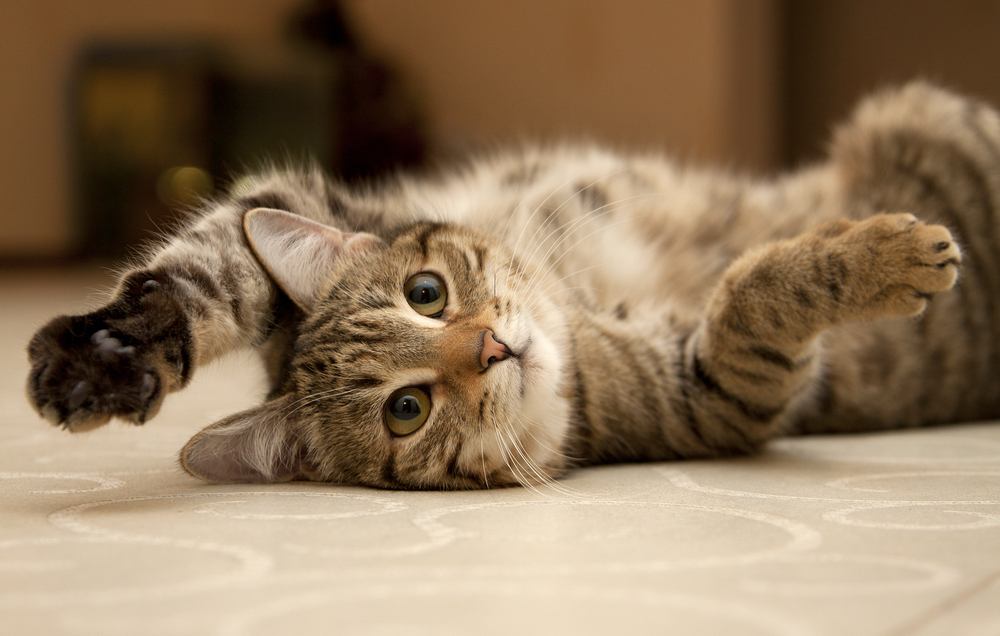
It can be upsetting when cats lash out at us, other family members, or guests. Remember that cats are sensitive creatures and unwanted behaviors are often a sign that they are feeling stressed or uncomfortable with a situation.
Swiping—when a cat swats at a person or animal with their paw, usually with their claws out—is often a warning sign that the cat is feeling overstimulated or even aggressive. Other accompanying signs of cat aggression include hissing, growling, raising their hackles, and in extreme cases, biting. Punishing a cat for behavior issues never helps the situation and can often make the unwanted behavior worse, but cat parents can learn to read their cat’s behavior to help head off these unwanted cat attacks.Key Takeaways
Here are a few of the possible reasons your cat might be swatting and swiping at people:
1. Underlying Medical Conditions
None of us feel our best when we’re ill, including cats. Before jumping to the conclusion that your cat’s swiping is a behavioral issue, it is important to rule out medical conditions that might be causing the aggressive behavior, especially if it has started suddenly or is out of character for your cat.
In fact, most behaviorists require a full health checkup from a veterinarian before beginning to work with you on behavior problems. For cats, anything that causes them to experience pain—either acute or chronic—might make them aggressive, such as:
- A cat bite injury or recent cat attack
- Stiff, sore joints from osteoarthritis
- Painful teeth due to dental disease
Other conditions, such as hyperthyroidism, are also associated with aggressive behavior. Left untreated, hyperthyroidism can cause weight loss, wasting, and circulatory problems, so it is important to take notice of any behavioral changes that might be warning signs.
Solution: Dealing with any animal behavior issue should begin with a trip to the vet. Cats in particular are often known as the great pretenders and can hide symptoms well, so a thorough checkup is warranted even if there are no obvious signs of disease.
2. Fear
Fear aggression might be the result of many different triggers. The fearful stimulus might be sudden and short-lived, or it might be an ongoing problem. For example, the flashing lights and loud noises from fireworks on New Year’s Eve might cause an otherwise relaxed and well-socialized cat to cower in a corner, lash out, and swipe.
Alternatively, a timid, less-socialized cat might show signs of aggression merely if someone new enters the household. The triggers might be different from cat to cat but could include dogs, children, new cats, and work on the house.
A cat’s body language can give clues as to whether they are swiping out of fear or stress. Fearful or stressed cats might show a hunched or flattened body posture, hold themselves tight, flatten their ears back, and have dilated pupils.
Solution: Solving fear aggression is not an easy or simple task and might be best achieved by working with a reputable behaviorist. However, you can take small, simple steps to make your cat feel as safe and secure as possible.
Having ready access to resources such as food and water bowls, a litter box, a secure place to hide/rest, and your affection will help to make any cat feel less stressed. Using pheromone sprays or diffusers can increase their feeling of calm. It’s always a good idea to introduce new cats, other pets, or lifestyle changes gradually when possible.
3. Play

Working with an animal behaviorist is recommended for cats that are swiping due to fear aggression.
Many of us will have been happily indulging in a playful session with our pet cat, only to have them suddenly jump up, swipe at us, and scurry off. Often this can be confusing, especially if your cat was seemingly loving the game just moments before.
This sort of feline aggression is not fully understood, but it is thought that it can occur when a cat experiences overstimulation from a game, and their predatory drive just takes over. Not unlike a toddler, sometimes a cat’s impulse control is not as good as it could be, and they forget to play nice.
It is thought that cats that were poorly socialized as youngsters, or those that did not grow up around other cats, might struggle with this more. Another theory is that something a cat was initially finding fun or pleasurable, can become annoying to them if it continues on for too long.
Similarly, we sometimes see petting-induced aggression, where cats abruptly decide that they have had enough and lash out.
Solution: Play aggression can be a difficult type of aggression to manage, especially as many of us do not want to forego playtime with our cat. The trick is to watch and read your cat’s body language for signs that they are getting overstimulated or that the aggressiveness of their play is escalating.
If it is, take things down a notch or have a short break. Also, provide your cat with plenty of playtime opportunities. A cat that is played with for short periods of time during the day and has access to plenty of toys even when you are not there is less likely to get too wound up at playtime.
4. Redirected Aggression
Perhaps the most challenging type of feline aggression to deal with, redirected aggression is where your cat may show aggressive behavior at one thing, as a reaction to something else. For example, imagine a cat watching birds out of a window.
The birds are stimulating the cat, tapping into its predatory nature. The cat might be wagging its tail and chattering at the birds through the glass. Then a family member walks past the windowsill, and the cat takes a swipe at them and scratches them. In this case, the cat was stimulated by the birds and perhaps frustrated at not being able to get at them. However, the emotions were taken out on the innocent passerby.
Another example might involve a new cat in the area that your cat finds intimidating. Instead of unleashing their aggression on this new, scary cat, your cat might choose to come inside and pick a fight with their housemate cat instead.
Solution: For obvious reasons, redirected aggression can be confusing, and sometimes difficult to know exactly what the cause is. In these cases, where you might be seeing feline aggression without definitively knowing the cause, it might be best to work with a behaviorist. They will likely take an in-depth history of your cat’s behavior, routine, and lifestyle and might be able to highlight things you didn’t even realize were relevant.
Cat Swiping: Final Thoughts

With a little detective work, it’s possible to uncover the reason your cat is swiping so you can work toward a solution.
In an ideal world, cats would never get upset or swipe at others, but cats are allowed to show their emotions just as we do. Our job as cat parents is to play detective on their cat behavior, and do all we can to raise happy, well-socialized cats.
Also Read: Why Does My Cat Hate Other Cats?
Frequently Asked Questions
Why is my cat swiping at other cats?
Swiping at other cats is one form of aggressive behavior in cats. Not all cats get along, and your cat might see other cats as competition for food, territory, or resources. Alternatively, if your cat’s body language is otherwise nice and relaxed, it might be a simple invitation to play.
Why is my cat swiping at my dog?
A cat that is swiping at a dog is likely showing an example of fear aggression. Scary or stressful situations can make cats swipe, hiss, or raise their hackles. If your cat is swiping at your dog, it is most likely using aggression to try to make your dog back off and leave them alone.
Why is my cat swiping at me?
Swiping can be a sign of many different types of feline aggression. Your cat might be feeling scared or defensive, or they may be feeling grumpy because they are sick or in pain. Alternatively, your cat might be showing signs of redirected aggression and using you as a way to express their feelings about something else entirely!







